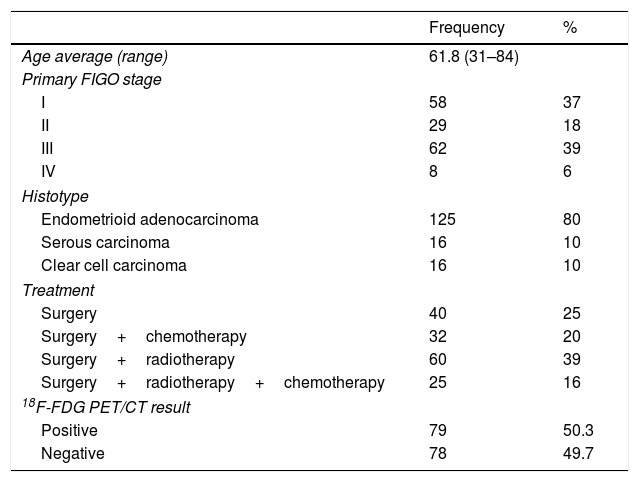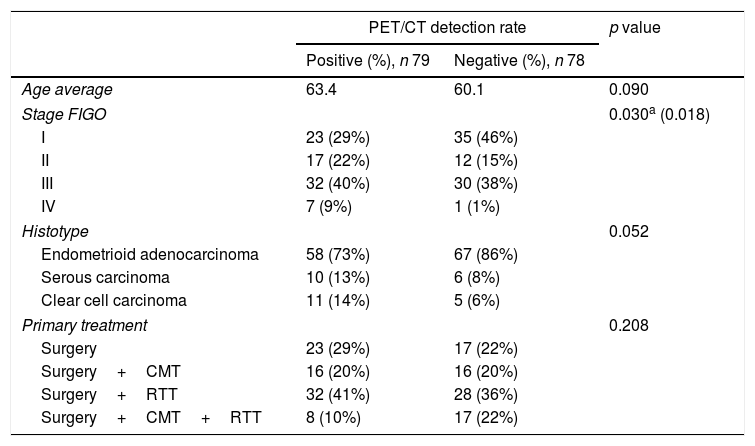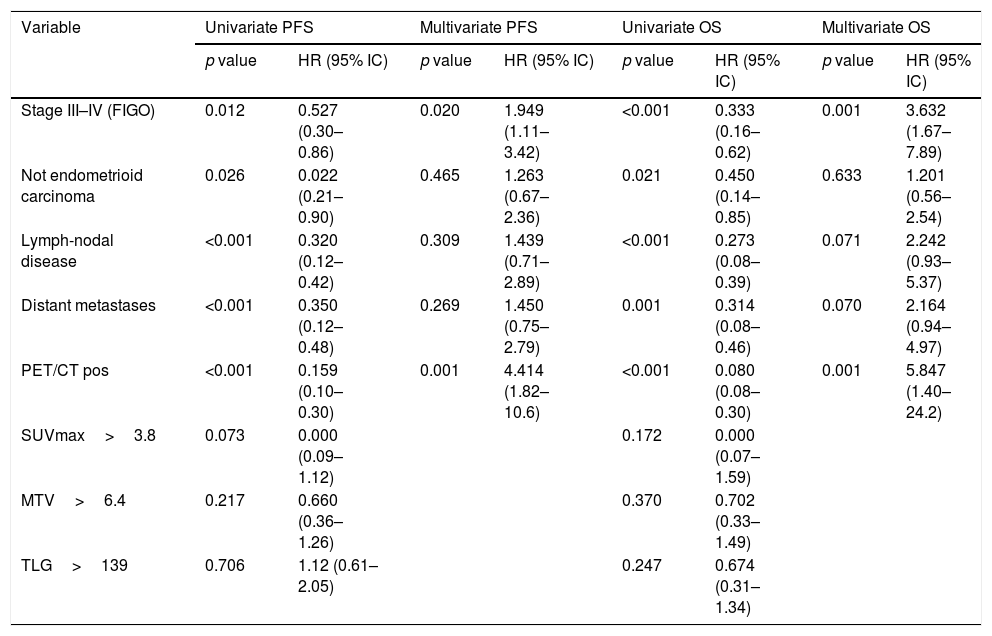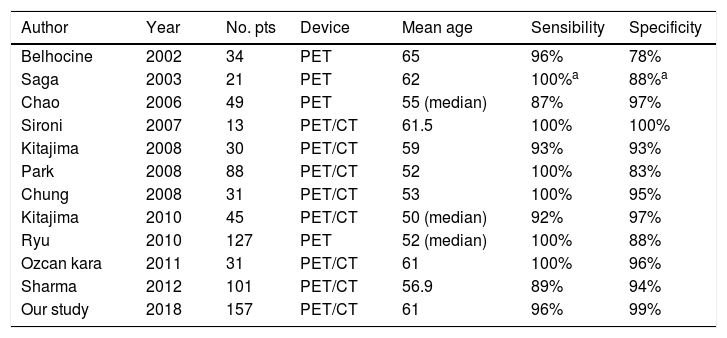Endometrial carcinoma (EC) is a cancer with a good overall prognosis, except in cases of recurrent or advanced EC. The aim of this study was to assess the diagnostic performance, the prognostic value and the impact on therapeutic management of 18F-FDG-PET/CT in suspected recurrent EC.
Materials and methodsWe retrospectively evaluated 157 patients with histologically proven EC and restaging 18F-FDG-PET/CT for suspected recurrence. The PET images were analyzed visually and semi-quantitatively by measuring SUVmax, MTV and TLG. A combination of clinical/imaging follow-up and/or histopathology was taken as reference standard. PFS and OS were computed using Kaplan–Meier curves.
ResultsSeventy-nine patients had positive 18F-FDG-PET/CT showing the presence of at least one hypermetabolic lesion consistent with recurrence, while the remaining 78 were negative. Sensitivity, specificity, positive predictive value, negative predictive value and accuracy of 18F-FDG-PET/CT were 96%, 99%, 99%, 96%, 97% respectively and were higher compared to conventional imaging: 97%, 62%, 72%, 96%, 80%. After a mean follow-up of 39 months, relapse/progression occurred in 58 patients and death in 37 with an average time of 22.1 and 27.6 months respectively. A positive 18F-FDG-PET/CT and advanced FIGO stage were significantly associated with shorter PFS and OS. PET/CT results had a significant impact on therapeutic approach in 33 patients: avoiding unnecessary therapies in 28 and modifying therapy in 5.
Conclusions18F-FDG-PET/CT has a very good diagnostic performance in patients with suspected recurrent EC and has an important prognostic value in assessing PFS and OS. Moreover, PET/CT allowed for a change in treatment decision in about 20% of cases.
El carcinoma endometrial (CE) es un cáncer con un buen pronóstico general, excepto en los casos de CE recurrente o avanzado. El objetivo de este estudio fue evaluar el rendimiento diagnóstico, y pronóstico y el impacto en el manejo terapéutico de la PET/TC con 18F-FDG en la sospecha de CE recurrente.
Material y métodosSe evaluaron retrospectivamente 157 pacientes con CE histológicamente probado y reestadificación de PET/TC con 18F-FDG por sospecha de recurrencia. Las imágenes PET se analizaron visualmente y semicuantitativamente midiendo SUVmax, MTV y TLG. Se tomó como referencia una combinación de seguimiento clínico/radiológico/histopatológico. PFS y OS se calcularon usando las curvas de Kaplan-Meier.
ResultadosSetenta y nueve pacientes tuvieron una PET/TC con 18F-FDG positiva que mostró la presencia de al menos una lesión hipermetabólica compatible con recurrencia, mientras que los 78 restantes fueron negativos. La sensibilidad, especificidad, valor predictivo positivo, valor predictivo negativo y precisión de la PET/TC con 18F-FDG fueron 96%, 99%, 99%, 96%, 97% respectivamente y fueron más altos en comparación con las imágenes convencionales: 97%, 62%, 72%, 96%, 80%. Después de un seguimiento medio de 39 meses, la recaída/progresión ocurrió en 58 pacientes y la muerte en 37 con un tiempo promedio de 22,1 y 27,6 meses respectivamente. Una PET/TC con 18F-FDG positiva y un estadio FIGO avanzado se asociaron significativamente con un PFS y OS más cortos. Los resultados de PET/TC tuvieron un impacto significativo en el abordaje terapéutico en 33 pacientes: evitando terapias innecesarias en 28 y modificando la terapia en 5.
ConclusionesLa 18F-FDG-PET/TC tiene un muy buen rendimiento diagnóstico en pacientes con sospecha de recurrente CE, y tiene un importante valor pronóstico en la evaluación de SLP y SG. Además, la PET/TC permitió un cambio en la decisión de tratamiento en aproximadamente el 20% de los casos.
Artículo

Revista Española de Medicina Nuclear e Imagen Molecular (English Edition)
Comprando el artículo el PDF del mismo podrá ser descargado
Precio 19,34 €
Comprar ahora













